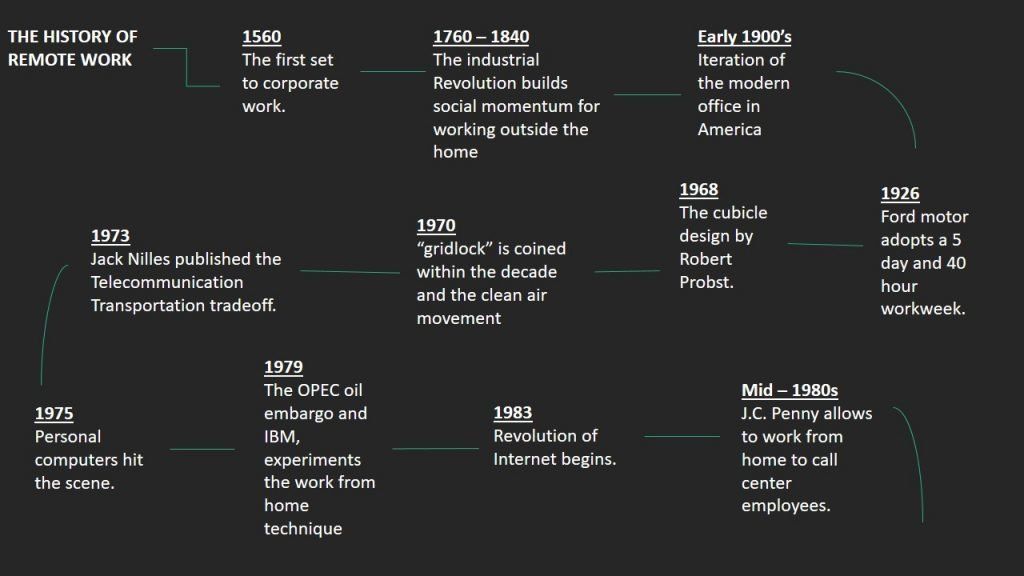Beat the ATS Systems
Smart Resume Builder
AI-optimized resumes that get past applicant tracking systems
4 min to read
Remote work is the work in which the company offers a job that we have to do from home. Remote workers do not work at the office, they just work from home and earn some money, remote work is easier for people because of the work from home. Early there are no more opportunities for remote workers but as time changed there are many changes in technology that influence remote workers, the internet plays a wide role in remote workers, and it made their work more easy and fast. Below there are some years that tell you the whole growing process of remote work and remote workers.

1560
The central administrative building of the Medici mercantile empire and the first-ever corporate office setup. Constructed by Florence’s Uffizi Gallery which was the first set of corporate work.
1760-1840
And at this time a strong social momentum toward working outside the home is the industrial revolution.
Early 1900’s
At this time the modern office begins to appear in America, which gave birth to a large part with many innovations such as the telephone, telegraph, typewriter, and public electricity.
1926
The time when Ford Motor Companies adopts a five-day and 40-hour workweek.
1968
The cubicle was designed by Robert Probst.
1970
At this time, the term “gridlock” is coined within the decade and the clean air movement without identifying remote work explicitly lays the significant groundwork for remote work to identify one of its greater benefits like zero commute time.
1973
This was the time when the telecommunication–transportation tradeoff was published by the physicist Jack Nilles, who worked for NASA's communication system. And now he is known as the Father of remote work.
1975
By this time, the first personal computers hit the era with 100k bytes of storage and 16k RAM and which carry a floppy space. with this time there are many changes in technology.
1979
At this time, it’s the sixth year of the OPEC oil embargo. An article – “working at home can save Gasoline” was published by The Washington Post. And general scepticism remains concerning remote work.
1979
And by this time, IBM also allows their five employees to work from home for an experimental purpose, and the experiment was also successful that time by 1983, roughly 2,000 IBM employees work remotely (work from home).
1983
And by time, the internet is born. And this era brings a large and vast change in technology and the internet connects everyone to each other, which is a kind of relief for remote workers, it makes their work easy and through many different social media platforms, it’s also easy to communicate.
The Mid-1980s
This mid is the start of a new era and J.C. Penney also allows call-centre employees to work from home which attracts people to work more from home.
1987
Big success comes at this time because the number of telecommuting Americans reached 1.5 million just because of remote work, people find it easy and time-saving by working from home and earning money from home.
1991
This time is again a revolutionary time with the invention of Wifi. And it's easier to work as well as share details and a good revolution to the internet. Wifi increases the use of the internet.
1995
By this time, Congress approves permanent funding for “Flexi-place” work-related equipment in the homes of federal employees which helps them to work. And by this time, one of the first hacker-space in the world, founded in Berlin named C-base. It’s the earliest model of co-working spaces.
2000
The DOT Appropriation Act is enacted requiring all executive agencies to establish telecommuting policies, which do not diminish employee performance.
2005
In San Francisco, the first official co-working space was created by Brad Neuberg a software engineer. And named the San Francisco Co-working Space.
2008
At this time the Enterprise social networking tool Yammer was launched, boosting the social networking platform to the next level where people work easily if they want.
2010
By this year, remote workers work over 59% of private because they work and get a proper income, as well as work from home which makes them relax and give productive work to the companies. And the President of the USA Barack Obama permits the Telework Enhancement Act and also create policies for remote workers.
2016
By this year, the growth of the Team collaboration tool Slack increased to 0 to 4 million active users daily.
2018
And at this stage, US companies jump from 26 in 2014 to 170 in 2018, there are fully remote workers in most of the companies. and the same time the world’s population of 70% works remotely at least once a week and 53% of the population at half a week which means more than half of the population works remotely in the world.
2019
In this current era, there is an increase of 5x from the year 2017. The video collaboration software zoom and reports tell that 50,800 customers with more than 10 employees work.
Beyond 2019
Beyond this year 99% of the people say that they would like to work in remote works as they earn from it and build their career in it.
Working from home eliminates lengthy commutes, enabling more time with loved ones. And on days when employees aren't required to attend video meetings, they can dress any way they choose.
A greater pool of potential talent (almost no geographical limitations) for employers. Employees keep full pay and benefits. Employees (and employers) save commuting time and costs.
Need expert guidance? Connect with a top Codersera professional today!